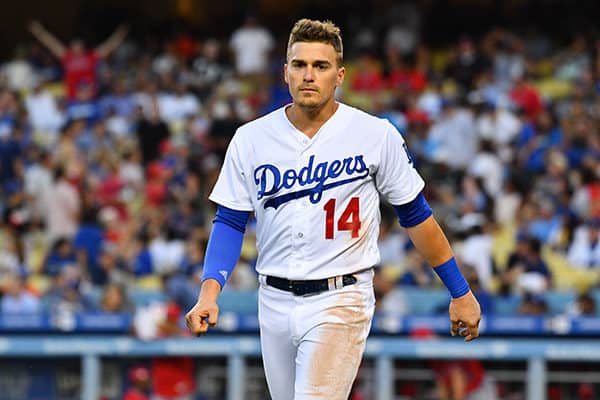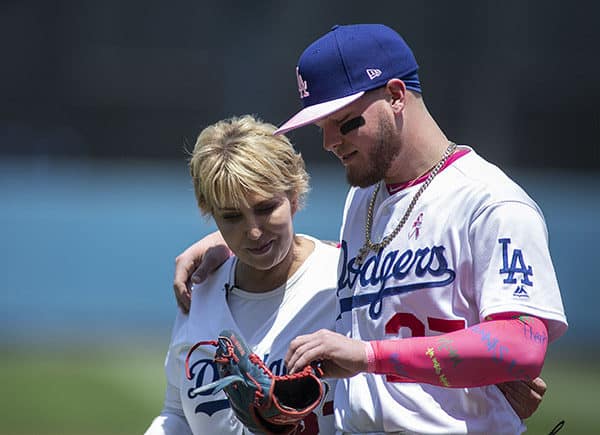Dodging Diversity
Peter Bradley, American Renaissance, June 24, 2019
The Brooklyn Dodgers have a special place in the history of major league baseball (MLB). They were the first team to integrate baseball by signing Jackie Robinson in 1947. The Dodgers (the name comes from Brooklyn pedestrians who had to dodge trollies) moved to Los Angeles in 1958.
The team is making a different sort of history this year with its often all-white lineup. According to Lineups.com, the Dodger’s regular starters are:
- Joc Pederson – Left Field
- Corey Seager – Shortstop
- Justin Turner – Third Base
- Cody Bellinger – Right Field
- A.J. Pollock – Center Field
- Max Muncy – First Base
- Kike Hernandez – Second Base
- Austin Barnes – Catcher
The team also has many white backup players who see a lot of action, including David Freese, Chris Taylor, Russell Martin, Will Smith, and Matt Beaty.
Four starting pitchers are white: Clayton Kershaw, Walker Buehler, Rich Hill and Ross Stripling. They are joined by two Asian starters: Kenta Maeda and Hyun-Jin Ryu.
The relief pitchers are a bit more diverse and include blacks Pedro Baez and Kenley Jansen along with mestizo Yimi Garcia. But the rest of the top relievers are white, including Scott Alexander, Dylan Floro and Joe Kelly.
Team manager Dave Roberts is half Asian and half black.
Two key players — Enrique Hernandez and Alex Verdugo — are Hispanic but very white.

Dodgers outfielder Enrique Hernandez. (Credit Image: © Brian Rothmuller/Icon SMI via ZUMA Press)

Alex Verdugo with his mom after throwing an honorary first pitch. (Credit Image: © Prensa Internacional via ZUMA Wire)
Overall, the 25-man active roster has 19 whites (including two white Hispanics), two Asians, two blacks (including one black Hispanic) and two mestizo Hispanics.
Too many whites
In an article published by Fast Company and timed for MLB’s opening day (March 28, 2019), “Dodgers Baseball: The Blue and Very White,” Alex Demyanenko noted that in 2017 the average MLB starting lineup was 57.5 percent white, 31.9 percent Latino, 7.7 percent black, and 1.9 percent Asian. Of course, a good number of the Hispanic players are from the Dominican Republic and are black or mulatto.
The Dodgers, however, have made the World Series two years in a row with heavily white teams. The past two years the team had some non-white stars, such as Yasiel Puig (black) and Manny Machado (Hispanic), but they moved on at the end of last season.
Mr. Demyanenko writes that nearly half the fans who attend Dodger games are Hispanic but does not give a source for this claim. From watching televised games, it seems the crowd is still mostly white, even though Los Angeles was only 28 percent white in the 2010 Census (it is surely less than that now). He wonders, “do the Dodgers or Major League Baseball in general have a responsibility to reflect a particular fan base or society generally?”
Mr. Demyanenko quotes black New York Times sports columnist Michael Powell: “I mean, their manager Dave Roberts is half black and half Asian . . . so it really astonishes me. . . . It feels tone deaf.”
Black sociologist Harry Edwards doesn’t like the Dodger lineup either:
On the opening day of MLB, every player in the League wears Number 42, Jackie Robinson’s number. The irony is that today, there are fewer than eight percent African-American players in MLB, and his former team has no black starters. It is an alarming trend that now sees many teams with rosters with only one or two African-American players.
Is an all-white starting lineup just a coincidence? Mr. Demyanenko suspects Andrew Friedman, Dodgers’ president of baseball operations, deliberately produced a similar lineup when he was with the Tampa Bay Rays a decade ago:
Friedman was signed as the Rays’ general manager in 2005 at the age of 28. In eight years, Friedman transformed Tampa Bay into a winner, even reaching the World Series in 2008 for the first time in franchise history. But the Rays (as they were called until 2008) also went from being one of the most diverse teams in the league in 2005 (nearly half the 40-man year-end roster was comprised of players of color) to one of the least by the time he left in 2013 (with only a quarter players of color). Is there a reason that goes beyond coincidence or pigment? The real reason may have more to do with a color not yet mentioned: green.
Friedman became the Dodgers’ President of Baseball Operations in 2014 and is known for relying on analytics, which focuses on finding diamonds in the rough. Some maintain Latino players require more of an investment, and tighter purse strings mean less emphasis on developing foreign players to reduce costs.
You can’t hire whites even if your team wins. Is Mr. Friedman guilty of putting talent ahead of diversity? Maybe having a non-white manager means he can afford to hire strictly according to talent.
The Los Angeles Dodgers may be ready to join the same club as football’s New England Patriots and the Duke college basketball teams of the 1990s and 2000s. Both teams are/were intensely hated for dominating their sports despite being heavily white. The Houston Astros team that made the 2005 World Series was also “too white.” Some fans are still bitter because the mostly-white Boston Celtics won three basketball championships in the 1980s.
Last week, the Toronto Raptors beat the Golden State Warriors in the NBA championships. The games had nine black starters and one white. No one wondered if the NBA is too black or if basketball teams have a responsibility to represent the demographics of their cities.
In any event, the Los Angeles Dodgers have the highest attendance in MLB by far, the best record in all of baseball, and lead their division by 11 games. Cody Bellinger leads the league in hitting and may well become the Most Valuable Player this year. As in other areas of American life, dodging diversity has proven to be a strategy for success.















